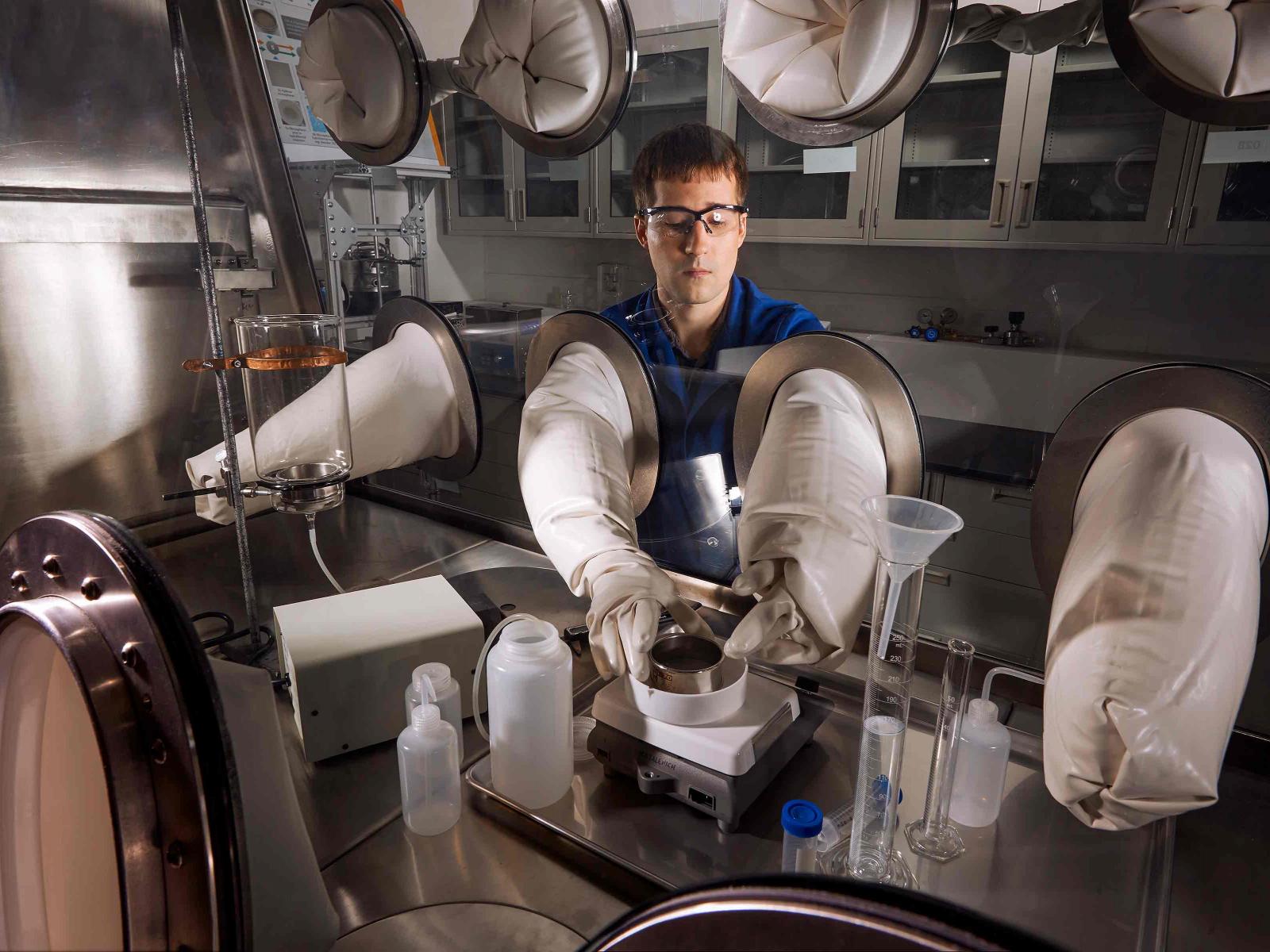This Historic PNNL Lab Runs 'Hot' and 'Quiet'

Jeff Katalenich, a recent PNNL Linus Pauling Postdoctoral Fellow, prepares equipment in a glove box for research on new, cleaner methods for processing plutonium-238 � a radioisotope used to heat and power space exploration probes and extraterrestrial rovers when solar power is insufficient. Rather than the very fine, easily dispersed powder used in conventional methods, he developed a wet method that reduces the risk of contamination.
Photo courtesy of Pacific Northwest National Laboratory
Peering through the thick, green glass of a decades-old "hot cell," an expert technician manipulates robotic arms to study highly radioactive waste from Hanford, in support of ongoing cleanup.
Nearby, in a recently refurbished "quiet suite," an exquisitely sensitive electron microscope reveals the atomic structure of plutonium, advancing scientific understanding of the metal that plays a central role in our community's history.
This juxtaposition of old and new is found in the Radiochemical Processing Laboratory, a 65-year-old facility that is essential to nuclear science and engineering research at the Department of Energy's Pacific Northwest National Laboratory.
For 65 years, RPL has been advancing solutions for environmental cleanup, nuclear security, energy and medicine.
Beyond hot cells, glove boxes and radiological fume hoods, this facility — known as RPL — houses specialized research equipment and scientific expertise in nuclear materials characterization, chemistry, physics and engineering to address the nation's most significant nuclear challenges.
The RPL was built to support uranium recovery and plutonium processing associated with Hanford operations in the 1950s and '60s. Its contributions to numerous programs over the decades have earned it a special place in history. Last November, the American Nuclear Society honored RPL as a Nuclear Historic Landmark.
The award recognized RPL's unique capabilities and how they underpinned scientific discoveries and technological solutions for environmental cleanup, nuclear nonproliferation, reactor safety and medical isotopes.
Harkening back to its roots, including studies in the late 1970s to investigate vitrification (where waste is solidified in a stable glass waste form), RPL still delivers solutions for Hanford cleanup. This spring, about three gallons of low-activity Hanford tank waste were vitrified at RPL, using a continuous process similar to that planned for the Vit Plant.
By demonstrating the process with actual waste instead of a simulant, researchers in RPL helped confirm the science and engineering as the plant moves toward full-scale operations.
RPL also serves a unique function related to global nuclear security and nonproliferation. It is the only radionuclide laboratory in the United States — and one of only 13 in the world — that is certified by the Comprehensive Nuclear-Test-Ban Treaty Organization to process air particulate samples collected at monitoring stations around the globe. Each year, RPL researchers analyze about 60 samples for the CTBTO, looking for signs of possible nuclear explosions.
In support of the Department of Homeland Security's efforts in counter nuclear terrorism, PNNL researchers recently established a test bed that replicates different ways plutonium can be processed. By identifying and capturing information about the resulting variations in color or density, for example, it may be possible to correlate plutonium with where it may have originated.
Addressing the need for safe and secure nuclear energy generation, PNNL developed dosimetry monitoring capsules that are custom-designed and constructed at RPL for specific reactor environments. After being installed in reactors at labs, universities and commercial facilities around the world, the capsules are returned to RPL for analysis that helps reveal radiation damage and the status of the reactor.
RPL is also contributing to the fight against cancer. Leveraging its capabilities, PNNL researchers have developed processes for making highly pure medical isotopes for research and treatment. Nearly 20 years ago, a patented process for producing yttrium-90 was licensed to a pharmaceutical company that now makes the isotope widely available.
Today, a new treatment developed by PNNL and the University of Washington is in clinical trials. This treatment is based on work at RPL to automate the radiochemical process for faster, purer production with more consistent quality.
For 65 years, RPL has been advancing solutions for environmental cleanup, nuclear security, energy and medicine. With DOE's recent approval to operate through at least 2045, it will remain an enduring asset for the nation and the world, bridging its historic past to the many contributions it will make in the decades to come.
Steven Ashby, director of Pacific Northwest National Laboratory, writes this column monthly. His other columns and opinion pieces are available here.
Key Capabilities
Our Facilities
Published: July 22, 2018